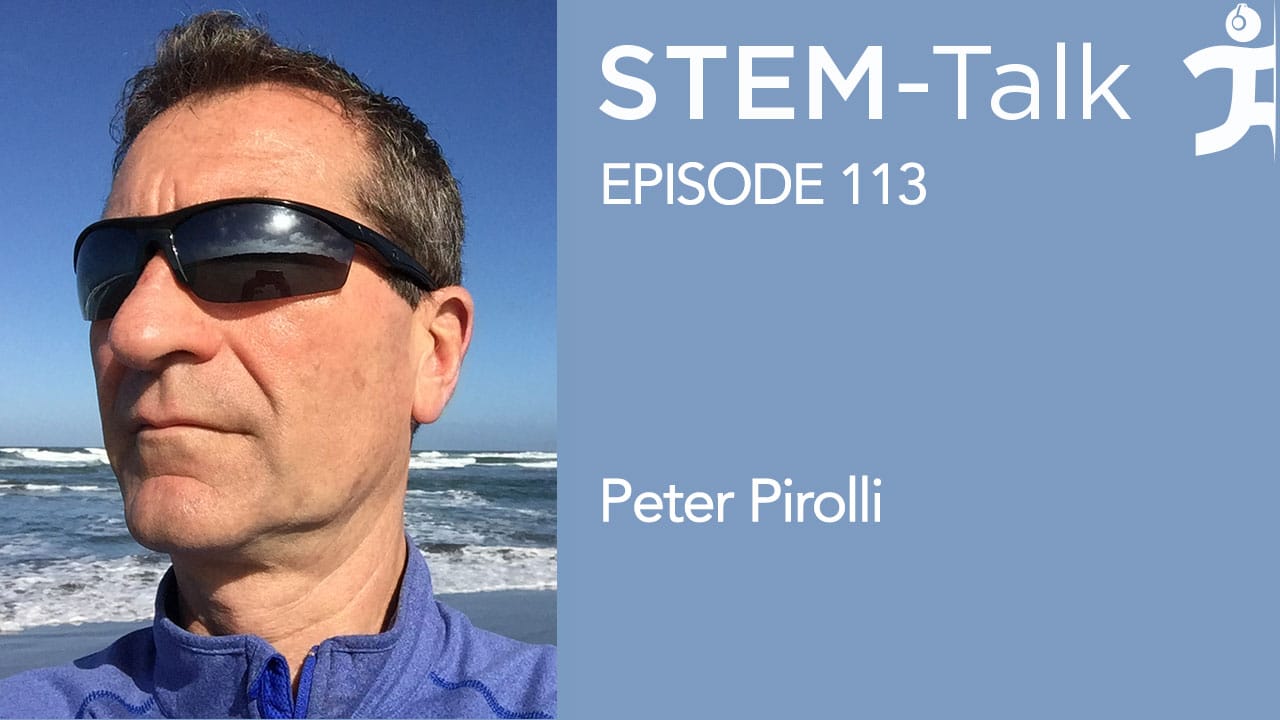STEM-Talk
Episode 113: Peter Pirolli discusses information foraging, AI and the future of human interaction with technology
// Oct 7, 2020

Today’s interview features Dr. Peter Pirolli, a colleague and senior research scientist here at IHMC since 2017. He previously was a fellow at the Palo Alto Research Center (PARC) and is known for his research into human information interaction. Peter’s work on information foraging theory led to his book “Information Foraging Theory: Adaptive Interaction with Information.”
Peter received his doctorate in cognitive psychology from Carnegie Mellon University in 1985 and throughout his career his research has involved a mix of cognitive science, artificial intelligence, and human-computer interaction. His current interests include disruptive mobile-health technologies for precision behavioral medicine to support healthy behavior.
Right now, Peter is working closely with IHMC’s Chief Science Officer Tim Broderick on a DARPA project that Tim discussed in his recent STEM-Talk interview, episode 112. Peter also talks about the project and the work that he, Tim and others at IHMC are doing to increase the biologic aptitude of elite warfighters.
In today’s interview, Peter also discusses his role as the principal investigator of a project that the National Science Foundation recently awarded to IHMC. Peter and his colleagues will be working on improving epidemiological models that will be able to more accurately forecast the rate of infections and deaths related to COVID-19.
Show notes:
[00:02:42] Dawn opens the interview by quizzing Peter about how he took up surfing at the age of 40. [00:05:48] Ken mentions that Peter grew up in Canada, but that his father, who is Italian, decided to move the family to Italy when Peter was 8 years old. Peter discusses what that was like. [00:08:37] Dawn mentions that Peter liked to go camping and canoeing as a kid, and developed a love for astronomy. Dawn asks if it is true that Peter used to keep NASA scrapbooks. [00:10:52] Peter tells the story of the role his mother played in his decision to go to Trent University in Ontario. [00:12:45] Dawn asks why Peter decided to major in psychology and anthropology despite his childhood fascination with astronomy. [00:14:47] Dawn asks what attracted Peter to Pittsburg and Carnegie Mellon University for graduate school. [00:16:12] Ken mentions that at Carnegie Mellon, Peter had the opportunity to meet and work with Herb Simon and Alan Newell, who back in the 1950s were the early pioneers of artificial intelligence. They won the Turing Award in 1975 for their contributions to artificial intelligence and the psychology of human cognition. Ken goes on to mention that Simon also won the Nobel Prize in Economics in 1978. Ken asks how Peter, with a background in psychology and anthropology, got to work with these pioneers of the field of AI. [00:17:59] Ken mentions that one of his favorite works from Simon and Newell was their physical symbols concept and the papers that arose from that. [00:19:54] Ken mentions that Simon and Newell were interested in developing computational models that could mimic and simulate what the human mind was doing. In addition to AI, they also conducted research that looked at information processing, decision-making, problem-solving, organization theory and complex systems. Ken asks Peter how working with these pioneers influence his later research and career. [00:22:57] Ken asks Peter to elaborate on the concept that Simon introduced known as “satisficing.” It’s a concept credited with revolutionizing economics by introducing the idea of “bounded rationality” where people have limited time and resources with which to gather data to draw their conclusions, as opposed to the “rational man” concept which assumes that a person making a decision uses all conceivably relevant information to inform their decisions. [00:25:54] Dawn mentions that in Peter’s time at CMU, he became interested in building artificial intelligence systems to tutor people one on one. Peter elaborates on this work and explains how it led him to travel across the country to work in Berkeley, California. [00:28:42] Ken mentions that Peter is particularly well-known for developing the concept of “information foraging” with Stuart Card in the late 1990’s. The concept was inspired by animal behavior theories and how animals forage for food. [00:33:42] Dawn explains that Peter’s work on information foraging led him to write his book “Information Foraging Theory: Adaptive Interaction with Information.” Dawn goes on to ask Peter about the concept of “high information scent” and what the significance of that is. [00:36:35] Dawn asks Peter to give an overview of his book which is aimed at an interdisciplinary audience. [00:39:10] Ken asks about Peter’s concept of “cooperative information foraging.” [00:41:33] Dawn mentions that the emergence of smartphones as a ubiquitous device led Peter to become interested in the possibilities of using them to support behavioral change in people. Dawn asks Peter to discuss the research he is conducting on ways to use smartphones to support health and lifestyle changes as well as alter habits. [00:44:28] Dawn shares her thoughts about how it is more effective to do this sort of research in the real world rather than studying people in a laboratory environment. [00:45:46] Dawn then mentions that one of the primary reasons that scientists study people in a lab is to control outside variables that could potentially influence or bias outcomes. She asks Peter how he studies people in the field and integrates these outside variables in his analysis. [00:47:19] Ken mentions that after knowing Peter for decades and admiring his work, Ken was able to convince Peter to join IHMC in 2017 as a senior research scientist. Peter explains what attracted him to IHMC. [00:50:17] Dawn mentions that Tim Broderick, who is the chief science officer here at IHMC, was just on STEM-Talk and discussed the interdisciplinary research team that he has put together for the Peerless Operator Biologic Aptitude project, otherwise known as PEERLESS. Dawn mentions that Peter is a key player in PEERLESS, which is a project designed to increase the biologic aptitude of warfighters so that they can increase their adaptability and resilience in extreme conditions. Peter discusses the project as well as his role in it. [00:54:09] Ken mentions that Peter became the principal investigator of a project related to COVID-19 that was just recently awarded to IHMC by the National Science Foundation. Ken asks Peter about the project, which will be working on improving epidemiological models that forecast the rate of infections and deaths related to COVID-19. [00:59:12] Dawn mentions that she has heard Peter talk about his belief that his interdisciplinary background is responsible for the productivity and success he has had throughout his career. Dawn asks Peter to talk about the importance of an interdisciplinary background in an academic world that insists on specialization. [01:02:17] Ken asks Peter to give his advice for young scientists currently attending college. [01:04:39] Peter tells the story of how he almost drowned as a result of hypothermia while surfing. [01:09:43] Ken asks about the quote Peter has on his website from Cormac McCarthy’s book “the road.” [01:13:46] Dawn mentions that she understands Peter has recently been reading William Gibson’s books and asks if Peter believes that the idea of uploading our minds to the cloud is possible or just science fiction. [01:15:17] Dawn closes the interview mentioning a photo on Peter’s website of him on a paddleboard with his dog Jake, and asks if Jake enjoys paddle-boarding as much as he looks like he does in the photo.





